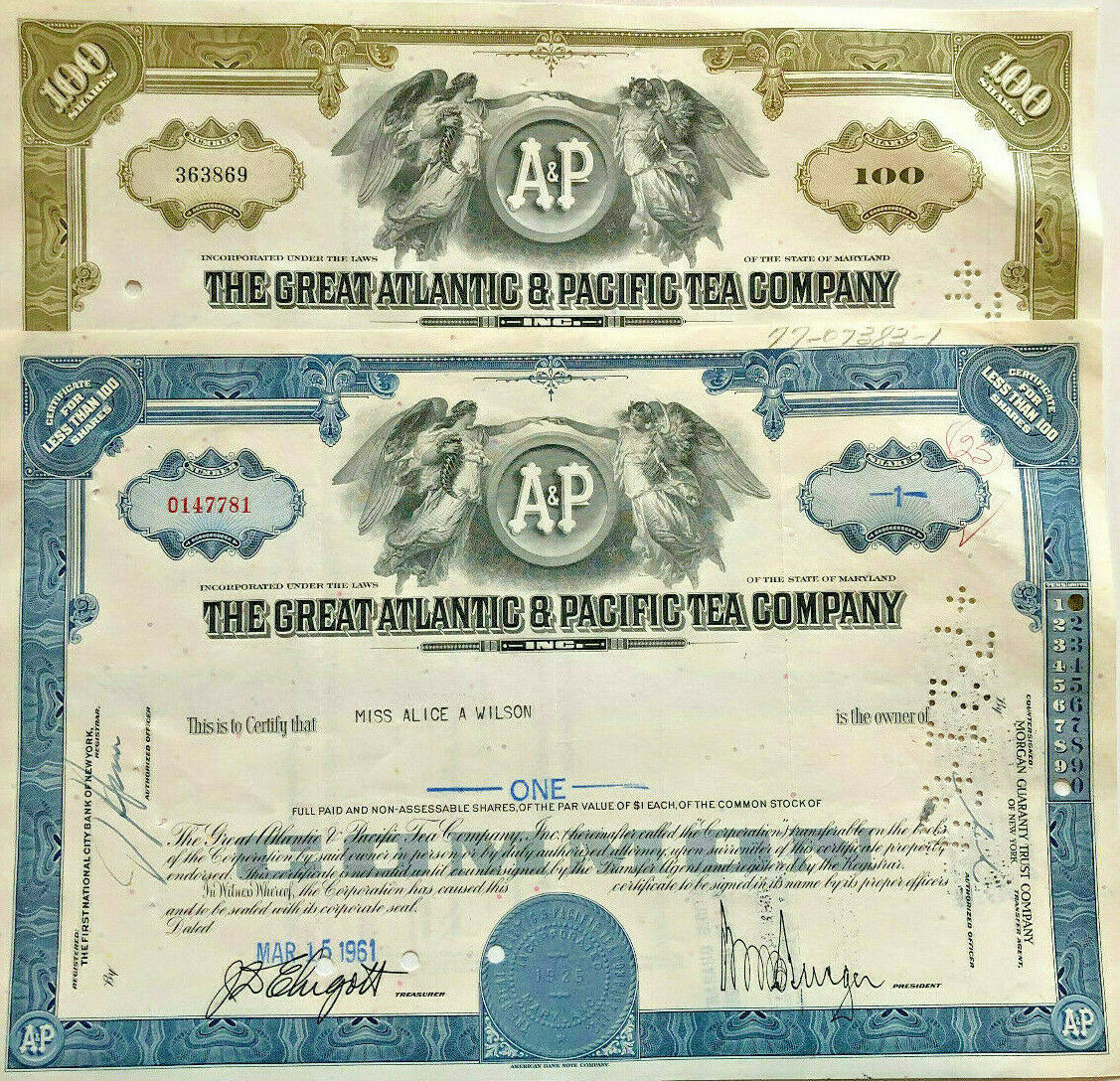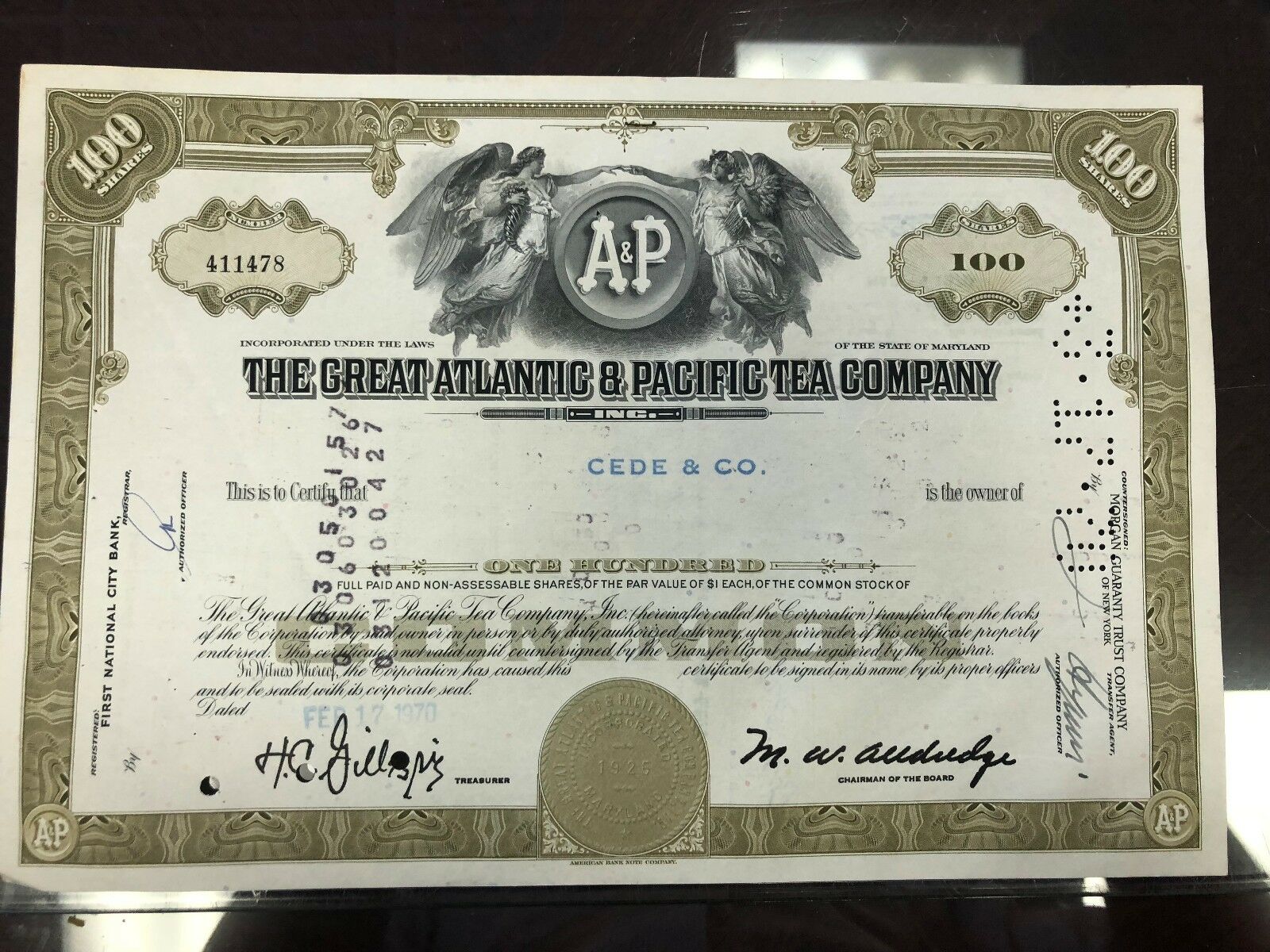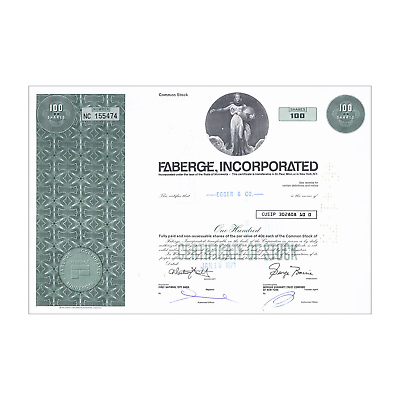-40%
Set of 2 > A&P supermarket store Great Atlantic & Pacific Tea stock certificates
$ 1.57
- Description
- Size Guide
Description
Old Stock Yard Collectible Stock and Bond CertificatesThe Great Atlantic & Pacific Tea Company
Set of 2 original stock certificates
Blue and Olive
Attractive certificates feature vignettes of two angels siding the A&P logo
More information about A&P's history:
The Great Atlantic and Pacific Tea Company
, better known as
A&P
, is a 447-store supermarket chain with locations in Connecticut, New York, New Jersey, Pennsylvania, Delaware, Maryland, and the District of Columbia under several banners. Its corporate and U.S. headquarters are located in Montvale, New Jersey. Supermarket News ranked A&P No. 21 in the 2007 "Top 75 North American Food Retailers" based on 2006 fiscal year estimated sales of .9 billion. Based on 2005 revenue, A&P is the 35th largest retailer in the United States. It was once the dominant food retailer in the nation.
History
The company was founded in 1859 as The Great American Tea Company by George Huntington Hartford and George Gilman in New York City. It was renamed "The Great Atlantic and Pacific Tea Company" in 1870, and George and John A. Hartford, founder Hartford's sons, joined the company in the 1880s.
The company originally focused on the tea business, selling tea by mail order from a storefront in Lower Manhattan. They were successful in capturing a large part of the market in the northeastern cities in the U.S. They purchased tea directly from Chinese tea plantations. Their low costs enabled them to undercut most of the market and grow. By 1876 they had 67 stores.
The 20th century
In 1912, the first A&P Economy Store opened, a grocery store format that allowed cost-cutting and standardized layout, increasing their store numbers to 1600 by 1915. By 1925 they had 13,961 stores and sales of 7 million. In the early 1930s, A&P was operating approximately 16,000 stores with a combined revenue of US billion. In 1936 A&P opened their first supermarket in Braddock, Pennsylvania.
In the 1950s, the pressure it put on its suppliers led to the passing of several anti-predatory pricing laws by Congress. The threat of having to break up the A&P company because of these laws led John and George Hartford to give an interview to Time, which put them on their November 13, 1950 cover. Time wrote that, next to General Motors, A&P sold more goods than any other company in the world. John was quoted in Time as saying "I don't know any grocer who wants to stay small. I don't see how any businessman can limit his growth and stay healthy". Up until 1958, the company was still controlled by the Hartford Family until efforts to make the company a publicly-owned corporation ensued.
In the mid-1950s, A&P was the dominant food retailer. In a few markets, A&P had up to 75% of the market share, with stores in 39 states. Downtown stores were being replaced with 15,000 to 20,000-square-foot (2,000 m2) supermarkets, which was large for that time period. In many situations a 20,000-square-foot (2,000 m2) store in a town would replace several 5,000-square-foot (500 m2) obsolete stores. In most locations these new stores had a colonial design with a weathervane on the top. On the west coast the stores had a round marina design.
The company continued building supermarkets with the colonial design throughout the 1960s. Most of these stores were on the edge of downtown areas. In the mid-1960s, A&P exited the west coast, selling those stores to Safeway, which was the number two food retailer at the time.
In the 1960s, A&P became less competitive in pricing and began losing market share as small regional chains began to grow in most markets. Still, A&P was the leading food retailer into the early 1970s while gradually losing market share.
At the end of the 1960s, A&P slowed down building new stores. They also stopped building their legendary weathervane designs. In the early 1970s, A&P fell from the number one position. They also were being surpassed in most markets in terms of market share. The chain also began losing money every year. Stores gradually went from dominating the market to underperforming. The company still built new stores, but very few compared to competitors. In some markets, the company was as low as number 5.
By the late 1970s, ongoing decline in profits, loss of money in the majority of its stores, decline in market share, and a recession caused a change in direction. This resulted in an abrupt exit of many markets and states such as Florida, Texas, Arkansas, Tennessee, Missouri, Illinois, Indiana, and others. The company greatly reduced its presence in the Southern markets as well as New England. The company still stayed active in the Mid Atlantic region including the New York City Metro area. Still, the chain closed well over half of its stores between 1976 and 1981. In 1979 the company was purchased by German retailer Erivan Haub, owner of Tengelmann.
In 1982, A&P began building larger stores, while remodeling some older stores that had potential. In 1982, Stop & Shop exited New Jersey, and A&P purchased most of these sites. They then replaced some of their obsolete stores with the somewhat more modern Stop & Shops. Perhaps the most major event for A&P in 1982, however, was the formation of the Super Fresh chain. Super Fresh replaced existing A&P stores in the Philadelphia metropolitan area, and remains open there today. In 1983, A&P bought Kohl's Food Stores (originally part of the Kohl's department store chain) in Wisconsin from BATUS. This would enable A&P to reenter Wisconsin and Illinois. (The Kohl's grocery chain was eventually closed in 2003.)
In 1986, A&P purchased a Long Island/Southern New England based chain called Waldbaum's as well as an upscale New York City-based chain, Food Emporium. These stores replaced the underperforming A&P stores in many cases. The company also turned a profit that year as well. A&P appeared to have made a comeback in the late 1980s. They began building larger 40,000-square-foot (4,000 m2) stores known as Future Stores. In 1989, A&P would acquire Farmer Jack stores based in Michigan and Ohio.
Still, in southern markets the chain still suffered. In the 1990s they exited Georgia, South Carolina, Alabama, North Carolina, Virginia, Kentucky, and Tennessee when the company began losing money. Many of these sites were sold to Kroger.
In 1993, A&P began a major overhaul of its stores in the mid-Atlantic region as well as New Orleans, Midwest (Farmer Jack and Kohls), Maryland, Philadelphia, and southern New England. Most of the stores below 40,000 square feet (4,000 m2) were shut down and replaced with stores ranging from 50,000 square feet (5,000 m2) to 80,000 square feet (7,000 m2). These stores now included pharmacies, larger bakeries, more general merchandise, among other things. These stores are known as Superfresh food markets. The majority of their stores today are this size.
Rise and decline in number of stores
Year No. of Stores
1876 67
1915 1600
1925 14,000
1930 16,000
1955 10,000
1965 5,000
1970 4,000
1978 3,500
1980 2,000
1990 1,000
2000 600
2002 500
2008 460
A&P had gone from over 10,000 stores in 1955 to about 5,000 in 1965. The number of stores fell because in most towns, several smaller grocery stores would be replaced by one larger supermarket so that by 1970, the company was down to about 4,000 stores. Another reduction in the number of stores occurred because of its West Coast exit. By 1978, the company was down to 3,500 stores due to its first round of market exits and reductions. By 1980 the company was down to about 2,000 stores, shrinking to 1,000 by 1990.
The 21st century
In 2000, the company was down to about 600 stores. In 2002, the company declared its largest loss. At that point, A&P exited Massachusetts, Vermont (only two stores), New Hampshire (one store), Illinois, and Wisconsin (with the folding of Kohl's Super Food markets). The company was down to just over 500 stores.
In 2004, A&P sold their large Canadian division (which maintained a large market share), as well as its Eight O'Clock Coffee division. The company was ranked No. 21 by Supermarket News in the 2007 "Top 75 North American Food Retailers" based on 2006 fiscal year estimated sales of .9 billion. It still operated over 400 stores through its A&P US unit in nine U.S. states (Connecticut, New York, New Jersey, Pennsylvania, Delaware, Maryland, Louisiana, Mississippi, and Michigan) and the District of Columbia. Sales that were almost billion several years ago have fallen, primarily because of the sale of the Canada unit.
A&P still operates ten other retail banners besides A&P, which include conventional supermarkets, food and drug combination stores, and discount food stores.
The company formerly operated 237 stores through its A&P Canada unit in the Canadian province of Ontario. On August 15, 2005, the company finalized its sale of the Canadian operations to Metro Inc., a grocery retailer based in Montreal, for CAN.7 billion in cash and shares of Metro. In 2008, Metro announced that the A&P name would be retired over the next year and all stores rebranded as "Metro". It has also announced plans to divest itself of its Midwest operations.
A&P has developed a new corporate slogan, "Fresh Thinking Since 1859." It had converted over 20 retail stores to its "fresh" format in 2005 and an additional 40 stores in 2006. The first Fresh Market was opened in Denville, New Jersey on August 20, 2004. Its "Fresh Markets" were previously "Super Food Markets". Its Midland Park, and Woodland Park, New Jersey stores, recently reopened as Fresh Markets, incorporate gourmet food, organics, a wine department and several food preparation counters which allow the consumer to taste and purchase fresh meals. This Midland Park store is the chain's #1 store by sales volume.
Its current Executive Chairman is Christian W.E. Haub, a member of the family that owns the Tengelmann Group of Germany. The President and Chief Executive Officer is Eric Claus. The Tengelmann Group bought a majority stake in A&P in 1979.
A&P revealed on February 27, 2007, that it was in talks to acquire Pathmark for 3 million. A few days later the company had agreed to buy Pathmark for 9 million (and ultimately bought Pathmark for .4 billion). This would allow A&P to be the number 2 grocery retailer in New York Metro areas as well as Philadelphia. This sale was completed as of December 3, 2007. Employees won't yet be mixed into each other's stores in the immediate future but may eventually.
A&P was currently involved in a lawsuit against two former employees over a music video produced at an A&P supermarket in Califon, New Jersey. In May 2008, the Courier News reported that the parties had settled. The precise terms of the settlement are confidential.
Pathmark is now the "price impact" format for the company. Starting in September 2008, eight Super Fresh locations in the Philadelphia market were changed to Pathmark Sav-a-Centers.
A&P is now embarking on its 150th year of operations in 2009.
Private brands, then and now
For many decades, the A&P supermarkets pioneered in the use of store brands. Eight O'Clock, Red Circle, and Bokar coffees, Our Own tea, Ann Page and Jane Parker foods were almost as notable to regular shoppers as the outside retail brands the store carried. (A&P's coffee line was a hallmark of the store from practically the beginning and received its Eight O'Clock moniker by 1920. It was once a bigger moneymaker than the retail stores themselves.) This practice was successful but drew criticism.
A&P branded butter wrapper from the 1960s.
A&P sold off Eight O'Clock Coffee to a San Francisco investment firm in 2003 (though the retailer continues to sell it). A&P replaced the Ann Page and Jane Parker labels with its America's Choice and Master Choice in-house brands. Added in 2008 and 2009 were the environmentally sensitive Green Way brand, Hartford Reserve (replacing Master Choice) and America's Choice Gold, a brand positioned between America's Choice and Hartford Reserve in terms of quality.
During the generic products trend in the 1980s, A&P established its own quasi-"brand" of generic products under the name "P&Q" (Price and Quality). Likewise, Tengelmann in Germany uses the A&P logo for its own range of generic products, translating as Attraktiv & Preiswert (Attractive and Affordable).
Current Banners
* A&P Food Market (includes A&P Fresh format & "Super A&P" format)
* A&P Super Foodmart (New England division)
* Food Basics USA
* The Food Emporium
* Pathmark ("Super-Center" and "Sav-A-Center" formats)
* Super Fresh
* Waldbaum's
Defunct Banners
* A&P Sav-A-Center
* Farmer Jack
* A&P Futurestore
* Kohl's Food Stores
* SuperPlus Food Stores
Canada
On August 15, 2005, A&P sold A&P Canada and Food Basics (Canada) to Metro Inc. The name of the Canadian units is owned by Metro Inc., and all stores under the A&P banner are found exclusively in Ontario. In August 2008, Metro announced that the A&P name would be retired and all stores rebranded as Metro.
~ Information from Wikipedia
Old Stock Yard Policies and FAQs
Please visit my eBay store
– any combined certificate purchased
ship free
with auction items!
Shipping and Handling Charges:
.99 for one certificate to the U.S.
.99 for one certificate to the rest of the world
Additional, combined certificate purchases
ship for free
!
Shipping Method and Timing:
Certificates are carefully packaged in poly bags and rigid envelopes to protect them during shipment. Items are sent via U.S.P.S. – usually first class, but occasionally priority or parcel post. Most items will be mailed within 48 hours of payment.
Payment Method:
In accordance with
eBay
policy, my listings are setup to accept
Paypal
payments. Sellers are allowed to accept other forms of payment only if the buyer requests another payment method – so if you prefer to pay using a method other than Paypal, please let me know.
Return Policy:
Items can be returned for any reason within 15 days of purchase. A full refund will be issued upon receipt of the return if the item is the same condition it was in upon delivery.
FAQs:
Are you your certificates authentic or copies?
Everything
I sell is original and authentic. I do not sell copies or reproductions.
Is the certificate pictured the exact one I will receive?
Usually, yes. Occasionally, I do list certificates of the same type without rescanning. In this case, the certificate you receive will be virtually identical (same color, size, vignette, etc.) to the one pictured. Again, if you ever receive anything from me you are not 100% pleased with, you can return it for a full refund.
What is the best way to store, protect, and display my certificate collection?
The best thing, by far, that I have come across for storing certificates are
profolios and sleeves made by Itoya
. You can purchase them in my eBay store. I have several sizes available.
Do the certificates you sell have financial value?
No, these certificates are sold as collectibles only; although they are authentic, they no longer hold financial value.









